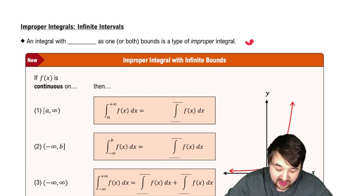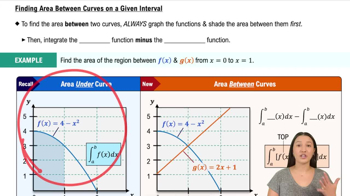Determine the area of the shaded region in the following figures.
Table of contents
- 0. Functions7h 54m
- Introduction to Functions16m
- Piecewise Functions10m
- Properties of Functions9m
- Common Functions1h 8m
- Transformations5m
- Combining Functions27m
- Exponent rules32m
- Exponential Functions28m
- Logarithmic Functions24m
- Properties of Logarithms36m
- Exponential & Logarithmic Equations35m
- Introduction to Trigonometric Functions38m
- Graphs of Trigonometric Functions44m
- Trigonometric Identities47m
- Inverse Trigonometric Functions48m
- 1. Limits and Continuity2h 2m
- 2. Intro to Derivatives1h 33m
- 3. Techniques of Differentiation3h 18m
- 4. Applications of Derivatives2h 38m
- 5. Graphical Applications of Derivatives6h 2m
- 6. Derivatives of Inverse, Exponential, & Logarithmic Functions2h 37m
- 7. Antiderivatives & Indefinite Integrals1h 26m
- 8. Definite Integrals4h 44m
- 9. Graphical Applications of Integrals2h 27m
- 10. Physics Applications of Integrals 3h 16m
- 11. Integrals of Inverse, Exponential, & Logarithmic Functions2h 34m
- 12. Techniques of Integration7h 41m
- 13. Intro to Differential Equations2h 55m
- 14. Sequences & Series5h 36m
- 15. Power Series2h 19m
- 16. Parametric Equations & Polar Coordinates7h 58m
9. Graphical Applications of Integrals
Area Between Curves
Problem 6.2.35a
Textbook Question
For the given regions R₁ and R₂, complete the following steps.
a. Find the area of region R₁.
R₁is the region in the first quadrant bounded by the line x=1 and the curve y=6x(2−x^2)^2; R₂ is the region in the first quadrant bounded the curve y=6x(2−x^2)^2and the line y=6x.
 Verified step by step guidance
Verified step by step guidance1
Identify the boundaries of region R₁. It is bounded by the line \(x=1\), the curve \(y=6x(2 - x^2)^2\), and the coordinate axes in the first quadrant. Since it is in the first quadrant, \(x\) ranges from 0 to 1.
Set up the integral for the area of region R₁. Because the region is bounded vertically by the curve \(y=6x(2 - x^2)^2\) and horizontally by \(x=1\), the area can be found by integrating the function \(y=6x(2 - x^2)^2\) with respect to \(x\) from 0 to 1:
\[\text{Area}_{R_1} = \int_0^1 6x(2 - x^2)^2 \, dx.\]
Before integrating, consider expanding the integrand \$6x(2 - x^2)^2\( to simplify the integral. First, expand \)(2 - x^2)^2$ using the binomial formula:
\[(2 - x^2)^2 = 4 - 4x^2 + x^4.\]
Multiply this expansion by \$6x\( to get the integrand in polynomial form, then integrate term-by-term over the interval \)[0,1]$ to find the area of region R₁.
 Verified video answer for a similar problem:
Verified video answer for a similar problem:This video solution was recommended by our tutors as helpful for the problem above
Video duration:
4mPlay a video:
Was this helpful?
Key Concepts
Here are the essential concepts you must grasp in order to answer the question correctly.
Definite Integrals for Area Calculation
Definite integrals are used to find the area under a curve between two points on the x-axis. By integrating the function that defines the curve over the given interval, we obtain the exact area of the region bounded by the curve and the x-axis or vertical lines.
Recommended video:

Definition of the Definite Integral
Setting Up Integration Limits from Geometric Boundaries
Determining the correct limits of integration is essential and depends on the boundaries of the region. For regions bounded by vertical lines and curves, the x-values where these boundaries intersect define the integration limits, ensuring the integral covers the entire region.
Recommended video:

Improper Integrals: Infinite Intervals
Area Between Two Curves
When finding the area between two curves, subtract the lower function from the upper function and integrate the difference over the interval where they intersect. This method calculates the net area enclosed between the two curves accurately.
Recommended video:

Finding Area Between Curves on a Given Interval

 5:23m
5:23mWatch next
Master Finding Area Between Curves on a Given Interval with a bite sized video explanation from Patrick
Start learningRelated Videos
Related Practice
Textbook Question
39
views
